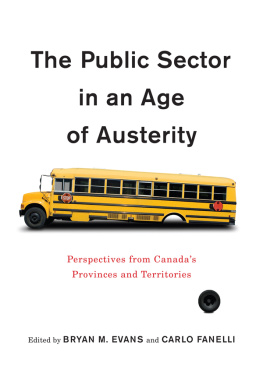Jamie Brownlee and Chris Hurl thank Bill Carrol and Wally Clement for all their support over the years, and for their inspiration in undertaking critical corporate research. Kevin Walby would like to thank Bilguundari Enkhtugs, Antigoni Lampovitiadi, and Brendan Anthony Roziere for their assistance. He dedicates this book to Terry Wotherspoon and Eric Kempthorne for getting him interested in sociology, as well as Dorothy E. Smith and Bill Carroll for their teachings, writings, and guidance. We thank everyone at BTL as well.
Introduction
Critical Perspectives on Corporatization
Jamie Brownlee, Chris Hurl, and Kevin Walby
Social activists and critical scholars have often used the concept of corporatization to describe the changing nature of the Canadian state over the past thirty years. The concept evokes the image of economic elites controlling public institutions and using business metrics to evaluate their performance. Corporatization is also used to describe the expanding discretion of senior managers to set priorities in health and social services, the creation of market-friendly public sector cultures, the development of new contractual arrangements between the public and private sector, and the capture of regulatory agencies by industry. In the popular press, the term corporatization is invoked to explain changes in areas as diverse as mental health, foreign aid, LGBTQ pride events, and the funeral industry. ()
Corporatizing Canada: Making Business Out of Public Service critically examines how corporatization has been implemented in different ways across the Canadian public sectorfrom schools, to criminal justice organizations, to utilities, hospitals, and food banks. What becomes clear is that there is no universal blueprint or master plan that is applied across these different areas. While the notion of corporatization might conjure the image of boardroom decisions being orchestrated by shadowy corporate leaders, the contributions in this volume show how corporatization involves a constellation of policies, programs, and practices that play out differently across institutional settings, shaped by distinctive histories, geographies, and forms of resistance.
In this introduction, we begin by highlighting three distinct but interlocking processes that our authorsincluding activists and scholarstouch on as aspects of corporatization that are implemented within government agencies, public institutions, and community organizations across Canada. These are: (i) corporatization as arms length administration; (ii) corporatization as expanding managerial control and business-like organization; and (iii) corporatization as public-private integration. By focusing on these three processes, we are not suggesting that there are no other practices that are part of corporatization or that these three aspects operate independently. Rather, we have focused on what appear to be the most prominent themes in this volume. We conclude with a discussion of neoliberal corporatization, including how it operates as a political and ideological process, and the threat it poses to democratic decision-making and the public at large.
Corporatization as Arms Length Administration
Corporatization involves implementing institutional arrangements positioned at a distance from the realm of formal politics. As David McDonald notes, this process creates arms length enterprises with independent managers responsible solely for the operation of their own immediate organization, and where all costs and revenues are accounted for as though it were a stand-alone company. ()
In Canada, there are many examples of arms length administrative arrangements in the delivery of public services. For example, EPCOR Utilities Inc. recently assumed control over water services in Edmonton. Whereas the municipality previously provided water services, EPCOR is organized through a board of directors that acts autonomously from the city. They are financially ring fenced and responsible for managing their own revenues, and politicians and political parties consequently have little say over how water services in Edmonton are managed, how rates are set, or how decisions about this vital public utility are made (see Lui, Chapter 15 in this volume). Other examples include BC Hydro, the Toronto Transit Commission, and Infrastructure Ontario. Each of these agencies operates at arms length from government, with decisions concentrated in the hands of a board of directors who act with a degree of autonomy in setting service priorities. It is the responsibility of these officials to ensure that the services continue to function and generate enough revenue to stay financially solvent.
The forms of corporatization that most deeply entrench private interests and result in commodification and commercialization reflect a distinct neoliberal character. Neoliberal corporatization represents the pinnacle of arms length services being run like businesses or being operated to create private profit. However, it is important to note that some researchers (see McDonald, Chapter 16 in this volume) argue that corporatized stand alone agencies can also operate in a more progressive way. With a focus on the Global South, McDonald argues that many corporatized utilities have bucked the neoliberal trend... openly resisting marketized forms of public management and retain a commitment to universality and equity. ()
Organizing public services through arms length forms of administration is not limited to neoliberal regimes. These forms of management have a long lineage, with variants of corporatization evident in liberal welfare, social democratic, and socialist regimes over the past century. Consider the movement towards public ownership by Canadian municipalities in the late nineteenth and early twentieth centuriesinitially through assuming public ownership over water and gas services, and culminating in the formation of larger provincial bodies and provincial and federal agencies such as Ontario Hydro and the Liquor Control Board of Ontario. () The formation of stand-alone public agencies in the wake of the Second World War was thought to depoliticize service delivery, making it a matter of technical administration, which could be implemented uniformly. Corporatization in this context involved the establishment of public agencies that stood at arms length from the corrupt patronage networks of political machines, and were managed by a body of impartial managers who were concerned with running services as cleanly and efficiently as possible.









